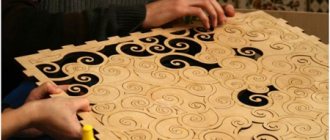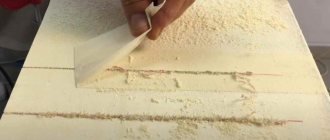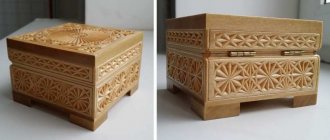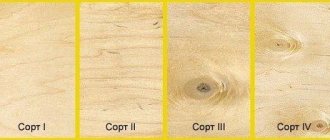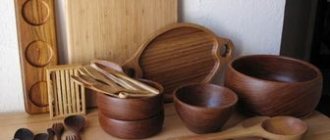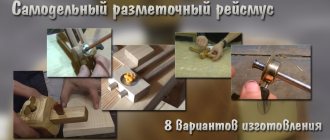How to cut smoothly with a jigsaw: recommendations
If this is the case, then it is better to make the cut with a circular saw.
- When it becomes necessary to make a cut on the inside of the workpiece, you should first drill a hole at the starting point.
- When working with the tool, do not use much force. An electric tool cuts wood quite well and without excessive pressure. If you apply serious force to advance the jigsaw, the saw and motor will become very hot and the risk of damage increases. In addition, excess pressure is the main cause of chipping.
- When cutting hardwood, it is advisable to add a little machine oil to the blade.
- Sometimes you have to work at low speeds. In this case, it is necessary to take frequent breaks from work, as the saw becomes very hot.
Main operating principles
The set of tools we need will consist of:
- Machine oil.
- Protective gloves.
- Points.
- Jigsaw.
- Processed material.
The fastening for the material being cut must be strong, at the maximum level.
With a crooked cut, there is a possibility of disturbances in the stability of the table. It is also necessary to check the strength of the position of the workpiece itself.
It is recommended not to cut wood along the grain if using a jigsaw. In this case, making an even cut becomes almost impossible.
It is better to give preference to a parallel fence if the need for such work still arises. One side of the stop is connected to the jigsaw. One of the edges of the wood product should be a stop for the other side. Then you can get an even cut.
Accuracy problems
Let's look at how to cut smoothly with a jigsaw:
- The object to be processed must be securely fastened. Moreover, in such a way that it would be convenient to make the cut.
- In cases of particular uncertainty or for greater guarantee of accuracy, it makes sense to use guides. When making a straight cut, you can use a wooden block fixed along the marking as a guide. If the cut shape is complex, then the situation becomes more complicated. In this case, you can use patterns, if any, or you will have to reduce the speed of work by more carefully guiding the jigsaw.
- One of the options why a jigsaw cuts crookedly is problems with the saw. It may be dull or have chipped teeth. If you notice that the jigsaw literally turns itself wherever it likes, inspect the saw.
- Jigsaw failure. For example, if the motor runs jerkily, the likelihood of a crooked cut increases sharply. Likewise, other mechanism failures can lead to a decrease in accuracy. Such problems are difficult to eliminate on site, as they require diagnostics and, possibly, repairs.
- Finally, the accuracy of the work is greatly influenced by the skill of the performer. If you are a novice carpenter, do not be discouraged by periodic failures: accuracy comes with experience.
Read also: What does IP54 protection mean?
Final stage
At the final stage, it is necessary to use another tool. To do this you will need a rasp or file, sandpaper, GOI posts, adhesive tape and a decorative corner made of duralumin.
The first step is to sand the wood. For this purpose, you can use a rasp or file, with which you want to remove excess. After this, use a sanding machine or regular sandpaper (zero grade will do) to bring the wood into a nice looking state. It is recommended to carry out this work even if you are not going to do anything after it. Due to the torn elements of the wood, the material will attract moisture much faster, which will cause faster wear of the material.
Chips
Another serious question is how to cut with a jigsaw without chipping? These are usually formed:
Avoid these actions and you will reduce the likelihood of chipping to a minimum. Also, some models allow the use of special anti-splinter inserts for jigsaws.
Anyone who has ever had to cut laminated chipboard or wood with a jigsaw knows that the material is almost never without chips.
You can, of course, use special files for finishing cuts.
Figure cutting
It is even more difficult to obtain curved surfaces of this configuration at home, while you will have to spend additional money on purchasing a router that will help you get rid of the chips and grooves formed when cutting chipboard. To cut chipboard, you must perform the following steps:
- Having marked the contours of the desired part on a sheet of chipboard, we cut it out with an electronic jigsaw, trying to cut off only a couple of mm from the intended cutting strip;
- We make design radius templates from fiberboard or plywood and painstakingly sand the ends with sandpaper;
- After attaching the template to the part to be cut, clamp it with clamps and process it with a hand-held bearing cutter, removing excess material exactly to the intended bevel line.
It doesn't matter what kind of cutter (2 or 4 knives). The only condition. The knives must accept the thickness of the cut and are processed along the entire height. After processing, all that remains is to glue the edges onto the part. How it's done. See:
Smooth cutting of material with a jigsaw
For example this one. But even they do not always provide a chip-free cut. So what should we do?
Let's look at why chips occur. Watch how the chip appears. When the finishing saw goes down, the teeth come out of the material, practically without sawing it or forming any chips. On the contrary, they saw upwards and the teeth at the exit catch the material and break it out. In wood, neighboring fibers cling; in laminated chipboard, chips stick together with the coating.
Now try sawing two layers of chipboard at once. You will find that the bottom layer has been sawn clean on both sides. If you think a little, it is not difficult to understand why this happened.
This happened because the top layer of laminated chipboard did not allow chips to form.
By carrying out these small observations and experiments, you can quite easily solve the problem of cutting with a jigsaw without chipping. So what should you do?
I would like to draw your attention to the fact that when drilling holes, the same picture is observed: at the exit of the drill, chips also easily form, so you need to press some unnecessary part from the exit side of the drill when drilling through holes.
Carpentry tricks Jan 21, 2014
Get access to the premium section
Subscribe to our newsletter
Several insertion methods
Let's take a closer look at how to cut a countertop for a sink. The main task that should be solved correctly when installing a sink is maintaining the geometry of the hole for installation in the countertop. At the initial stage, we need to decide which installation method we will use.
Note!
The main thing is to take into account the design features of the sink.
There are several types of installation.
The upper edges of the sink are located below the level of the countertop surface . Outwardly, this method looks strict and quite attractive, and is used for expensive headsets. When performing it, certain requirements must be met:
- you should have special tools, washing certain forms;
- The cut edges of the tabletop must be treated with a water-repellent compound.
Sink insert flush with countertop . It is important to correctly perform preliminary surface preparation:
- areas that will come into contact with the sink are worked on with a special tool, recesses are made equal to the thickness of the sides of your sink,
- This work is quite complicated; the hole for the sink must be done with great care.
The sink is installed slightly above the countertop level . The method is the simplest and does not require much effort. You can install the sink this way yourself, with a minimal set of tools.
How does a handheld circular saw attachment work?
The device in question is extremely simple and consists of only a few parts: a base for the saw, a guide rail, a thrust block and an eccentric clamp that ensures reliable fixation even on lumber that has been loosened with slight deviations in width.
Diagram of a device for a hand-held circular saw.
The homemade product is very easy to use. First, markings are made on the board.
Then a homemade device is installed on top, the lower stop of which is pressed against the edge of the workpiece, and the right edge is aligned with the mark.
Photo of a device for a circular saw.
Next, the plywood base is securely secured by turning the lever of the eccentric clamping mechanism.
Photo of the device - view from the bottom.
Now all that remains is to place the circular saw on the base and make the cut, pressing the edge of the sole against the guide side stop.
Cross cutting of boards using a manufactured device.
The result will be a perfectly even cut that exactly follows the markings.
With this device it is convenient to make many cross cuts when you need to frequently move the tool to a new cutting line, for example, when making grooves in beams. It is also useful if it is necessary to reduce the length of the workpiece by several millimeters, and it will cope with this task no worse than a miter saw.
Choosing the right tool
A few recommendations from experienced professionals will help you choose the right tool for the job.
For cutting at home, a household or semi-professional D-shaped jigsaw, which can be operated with one hand, is sufficient. The more power, the heavier the jigsaw, and it will be more difficult for it to cut smoothly.
A step speed controller, an electronic stabilizer and a pendulum stroke will greatly facilitate the cutting process. The presence of a plastic pad on the sole will allow you to securely secure the machine to the cutting blade. Useful features include built-in airflow and lighting.
It is worth paying attention to the fastening of the canvas. Some models have a restriction that does not allow the use of any file.
It is not recommended to cut boards with a jigsaw; there are circular saws and hacksaws for this. Although a powerful tool can cope with the task, it is unlikely that it will be possible to achieve a perfectly even cut.
Each jigsaw model differs in shape, so before purchasing it is worth holding the tool in your hand, and, if possible, testing it directly in the store.
How to make a device with your own hands
The cutting device is made for a specific model of power tool. On your circular saw, measure the distance from the engine to the bottom plane of the sole and subtract 5 mm. The result obtained is the height of the guide stop.
Removing the required dimensions of the circular saw.
Prepare a plywood base with right angles and wooden slats with parallel edges according to the dimensions.
Blanks for assembling a device for cross-cutting with a circular saw.
Measure the distance from the cutting blade to the edge of the sole.
Read also: How to make a ringing call with a multimeter
Add an allowance of 6–10 mm and install a guide rail at this distance from the right end of the plywood. Secure the plank with countersunk screws, ensuring its strictly perpendicular position.
Screw the stop block on the back side and fix the device on the workbench.
Cut the plywood to the final width with a circular saw, creating a reference edge for precise positioning of the jig along the markings.
Draw a template for the cam clamp cam on paper.
Drawing of an eccentric clamp.
Mark the piece on 10mm plywood and use an awl to mark the center of the drill hole for the bolt.
Cut the workpiece with a jigsaw.
Make a washer with a diameter of 50 mm from the same plywood using a ballerina extendable wood drill.
Sand the workpieces and select an M6 or M8 furniture bolt with a mustache (or with a square headrest), a handwheel nut, a washer and a bushing. The latter can be made from a tube of suitable diameter. The length of the sleeve is the total thickness of the base, lever and plywood washer.
Ready-made plywood eccentric.
Make holes in the base with a drill according to the diameter of the bushing, which serve to rearrange the eccentric clamp according to the width of the board being cut.
Hole drilling diagram.
Assemble the eccentric mechanism: insert a bolt with a sleeve on top, and install a wooden washer, the cam itself and a steel washer from below. Tighten the parts with a nut.
Stick a strip of sandpaper on the inside of the stop to prevent slipping when the eccentric is locked, which can happen when the device is fastened to a smoothly planed workpiece.
The clamping system of this device has a stroke that ensures fastening on boards with a spread of approximately 10 mm in width. If you need to cut or trim pieces of a different size, simply place a wooden block in front of the stop beam.
An example of using a device for cross-cutting a board of smaller width with a hand-held circular saw.
If desired, the potential of the considered device can be expanded by adding a cutting angle of 45°. To do this, you will need to slightly increase the dimensions of the support platform and install a second thrust block at a given angle.
What else do you need to know?
When you plan to saw off everything without chipping on one side, it is permissible to use files with both upper and lower teeth.
Most craftsmen prefer small files with straight teeth. Such devices chip less material, but still work quite well. After cutting, it is best to process the ends with emery stretched over even bars. If you don’t have a ready-made crayon of a suitable color, you can mix different crayons, like paints in an artist’s palette, and get a new color. To cut without errors and quickly, you must always take into account the brand markings. There is no generally binding designation standard yet, but almost all companies strictly follow the classification developed by Bosch specialists. Or at least they list it along with their own abbreviations and terms. CV saws (sometimes referred to as HCS) are well suited for cutting wood and wood-based products.
Hardwood files are intended for processing laminated panels (they are also useful, note, when processing hard wood).
Some inscriptions indicate in which mode the tool works optimally:
basic - a simple blade that allows you to make a clean cut of high quality;
speed - a device whose teeth are set apart (this allows you to cut faster);
clean - a blade that has not been cut (usually gives the cleanest cut).
If the workpiece is relatively thick, it is preferable to have a saw blade with large cutters that are not set apart, then the deviation from the vertical will be minimal. A longitudinal (relative to the fibers) incision is most often made with helical saws. For a transverse one, a straight blade is better suited. When you plan to make a piece of furniture, it is advisable to choose a less productive, but more accurate tool. Since most saws produced today cut the material as it is pulled in, the workpiece will need to be processed from the inside out.
How to cut a circle with a jigsaw safely and quickly?
- Date: 09/23/2015
- Comments:
- Rating: 13
Often the question of how to cut even circles from plywood with a jigsaw confuses novice craftsmen. After all, doing this is much more difficult than a simple straight cut; no saw will help here.
Drawing of a hand jigsaw.
Most often, a jigsaw helps to cope with the task of figure cutting. Jigsaws are manual and electric. A manual jigsaw consists of a frame with blade clamps and a handle. The main disadvantages of a manual jigsaw: low mechanical strength of the blade and small frame size. As a result of this, the blade often breaks and it is impossible to cut at a large distance from the edges of the part. These jigsaws are usually used for processing wooden products. There are regular jigsaws, in which the saw is positioned vertically, and for artistic cutting, where the cutting element is a steel blade. Electric jigsaws are usually used when working with thick material.
Professional secrets
Cutting with a jigsaw according to the drawing
It is necessary to check how firmly the canvas is fastened.
This mechanism may have its own characteristics depending on the manufacturer.
It is recommended to ensure the reliability of the fastening before starting work.
To work with any cutting tools, the fastening of the blade, its general position, is really important.
It is best to read the instructions that come with the kit in advance.
A useful device would be a system responsible for removing sawdust. Its operating principle is very simple. There is a flow of air from the fan cooling the motor.
It is used to remove debris. The removal system makes the cut line more visible to the master's eye.
The drill can be easily changed when cutting holes using a technique called "pocketing". To do this, just tilt the jigsaw forward, then the rounded tips will rest on the surface being cut.
The blade should be positioned above the future cutting line with maximum accuracy. You need to lower the support saw horizontally and then continue cutting.
Key rules
To make the sawing process simple and fast, you must follow the basic key operating rules:
To ensure that the edges of the plywood are even, it is better to cut along the blade.
- You can only work with dry material, since humidity increases the resistance of the material, as a result of which the veneer may begin to delaminate;
- it is necessary to change the cutting blade immediately after the first signs of dullness of the teeth appear;
- It is better to work with a jigsaw along the fibers of the material, so the edges will be smoother;
- Use a hand jigsaw to cut across the grain of the veneer.
To ensure safe work, you must adhere to the following recommendations:
- securely fasten the sawing table and the file in the frame;
- the jigsaw must have serviceable and well-fitted handles;
- You should not press the jigsaw too hard, trying to “help” it, this will only lead to an acceleration of dulling of the working blade;
- It is best to make straight and long cuts with a wide blade, so the cutting process will go faster;
- You must always see the markings, so sawdust must be removed from the material being cut by hand, and under no circumstances should you blow it away, as it can get into your eyes.
Following these simple rules will help a beginner learn how to cut circles with a jigsaw and make his work easier.
Correct sawing technique
Cutting and fitting plywood
The most difficult question is choosing files with the appropriate size for this tool.
There is a very wide range of these products on the market.
And many of them are only a few millimeters thick.
The main thing is to remember that these files are only enough for a couple of hours of work.
And they must be handled very carefully.
The smallest saws can only process plywood.
If the material is harder and dense, it means you need to take a larger file. This will also help answer the question of how to cut plywood smoothly.
Cutting instructions
Before starting work, you need to drill a hole in the plywood for the jigsaw blade.
To cut even circles with a jigsaw quickly and beautifully, you don’t have to be an expert in this field, but for a beginner it can be a very difficult task. In this matter, the main thing is patience and, of course, the presence of the necessary accompanying tools, such as the jigsaw itself, a file, a compass, a simple pencil and devices for polishing the surface.
Read also: Repairing a Vitek microwave oven with your own hands
The first thing to do is draw a circle on the surface of the material you will be working with. It would be best to use a compass or select a suitable circle and trace it. You need to trace with a pencil so that traces of it can be erased in the future.
If you need to cut a circle inside the surface, you should make a through starting hole. Next, you need to insert a jigsaw blade or file into this hole and secure the free end of the file with a clamp. It is recommended to cut while sitting. First of all, you need to secure the file in the jigsaw using a key, keeping in mind that the teeth of the file should be directed downward.
Nuances of chipboard processing
First of all, let's look at all the materials and tools that will be needed for the job:
- the laminated chipboard itself;
- pre-sharpened blade;
- jigsaw;
- ordinary jigsaw.
By the way, chipboard in the furniture industry and construction began to be used only in 1940 in the United States of America, but after a fairly short time the popularity of this material increased and spread throughout the world. Thanks to this, the industry has made a significant step forward, and all sorts of varieties of this material have appeared.
One of the most popular and frequently used types is laminated chipboard, which is not just a product of pressing sawdust with glue, susceptible to high temperatures, but also acts as an additional chemical and physical protection in the form of a melamine film.
Usually, when cutting chipboard, no complications arise, but with laminated chipboard, this seemingly simple process can become complicated. The fact is that countertops are often coated with multilayer HPL plastic from the manufacturer. This significantly complicates the sawing process. This coating can vary significantly in quality and basic properties, and it is not always a polymer coating. Therefore, when processing this material, many different nuances arise.
Step-by-step description of the process itself:
- Using a well-sharpened blade, a groove 2-3 mm deep is made. If there is a polymer coating of various types, it is recommended to slightly warm up the blade, and then immediately begin direct use. Due to the resulting pressure of cold steel on hard plastic, even if the sharpening is very good, minor microcracks and chips may occur, which is best avoided if possible.
- Using a tool called a jigsaw, you need to make the cut carefully and smoothly. During operation, it is important to carefully adjust the direction of the blade. If there are places where the direction changes, it is better to use an ordinary hand jigsaw as a secondary, auxiliary tool. Or you can use the thinnest file in a jigsaw. But this is not always convenient.
After the work has been done, you can proceed to the final stage of sawing the chipboard.
How to saw chipboard without chipping
You need to cut from top to bottom. The tool should be held straight to avoid nicks and bevels.
The main thing in this process is not to rush and cut smoothly without sudden movements.
It is necessary to take short breaks during the sawing process, as the file may overheat and break. Now the circle is ready. Now it is recommended to use a file to straighten the edges, erase the markings left by the pencil and polish the part. If necessary, it can be varnished.
Of course, sawing with a jigsaw requires certain dexterity and skills, but everything comes with experience. Therefore, following the recommendations described above should help the novice master in mastering this interesting and exciting activity.
Do you need to make a perfectly round hole in plywood or board, but don’t have any special tools at hand? This article is for you.
Hello everyone, dear friends. This is rather my last article here, I think it will be interesting to many. I encountered the following problem: I needed to make an even circle in the plywood under the speakers, but there were no tools for this, this device was invented. The device is very simple, anyone can make it, and it is very easy to use.
For this “device” we need:
– a board 20-30 cm thick, 2-3 cm thick – two self-tapping screws – a screwdriver – and something in which the hole will be made
You screw one screw into the middle of the board or a little closer to the edge, as convenient
Next, measure the required diameter, measure it on the board and mark it, screw in the second screw
This is roughly what it should look like
Now we screw the central screw through into the plywood, and slightly unscrew the second one so that its “sting” sticks out slightly from the board.
And we begin to rotate the board, thereby cutting through the board or whatever you call it
Each time, as soon as the board becomes easy to move, we screw the screw in a little inside, and thereby cut further and further into the circle
Here is the final result, the hole has already been cut, everything is perfectly smooth, if desired, you can sand it to give a smoother surface
That's all, we cut an even circle without any costs or special tools.
As it turns out, not many people know that you can easily cut a perfectly round hole of any diameter in plywood.
And I decided to share this method with you.
To do this we need a piece of rail and two self-tapping screws.
Divide the diameter of the future hole in half and put two marks on a piece of wood.
Then we drill according to the marks.
And screw both self-tapping screws into the drilled holes so that their ends protrude by 5-8 mm.
Now we align the first tip of the self-tapping screw to the center, and with the second, applying a little force, rotate it around the axis
Having reached the middle of the thickness of the plywood, we turn it over and perform the same operation. Don't worry about the center getting lost. Scrolling in place, the central self-tapping screw drilled a hole.
Using the example of a piece of krages, you were convinced that it is not so difficult to cut out a perfect circle without special tools.
In this way I cut holes in 10 mm thick plywood.
And of course, in the video you can watch the whole process in detail.
BEING THE AUTHOR OF THIS ARTICLE, I PROHIBIT COPYING TEXT, PHOTO AND VIDEO MATERIAL FROM THIS SITE TO OTHERS.
Euro-sawing – flawless connection of tabletops without seams
The guarantee of long service life of a kitchen work surface is the reliable connection of its parts. It is possible to connect the tabletop at a right 90 degree angle or in a straight line, if the kitchen footage allows for placement along one wall. There are three main methods of merging, but you should always adhere to one result - the surface should give the impression of a single whole:
- joint to joint without euro-saw;
- using a T-shaped metal profile;
- joint using a euro saw.
You will have to familiarize yourself with all the methods, not only with the euro saw. After this, you can decide how to connect the countertops to each other and make a choice among these options.
hunter_cbx
Honestly, the title “How not to cut a countertop” would be more correct
